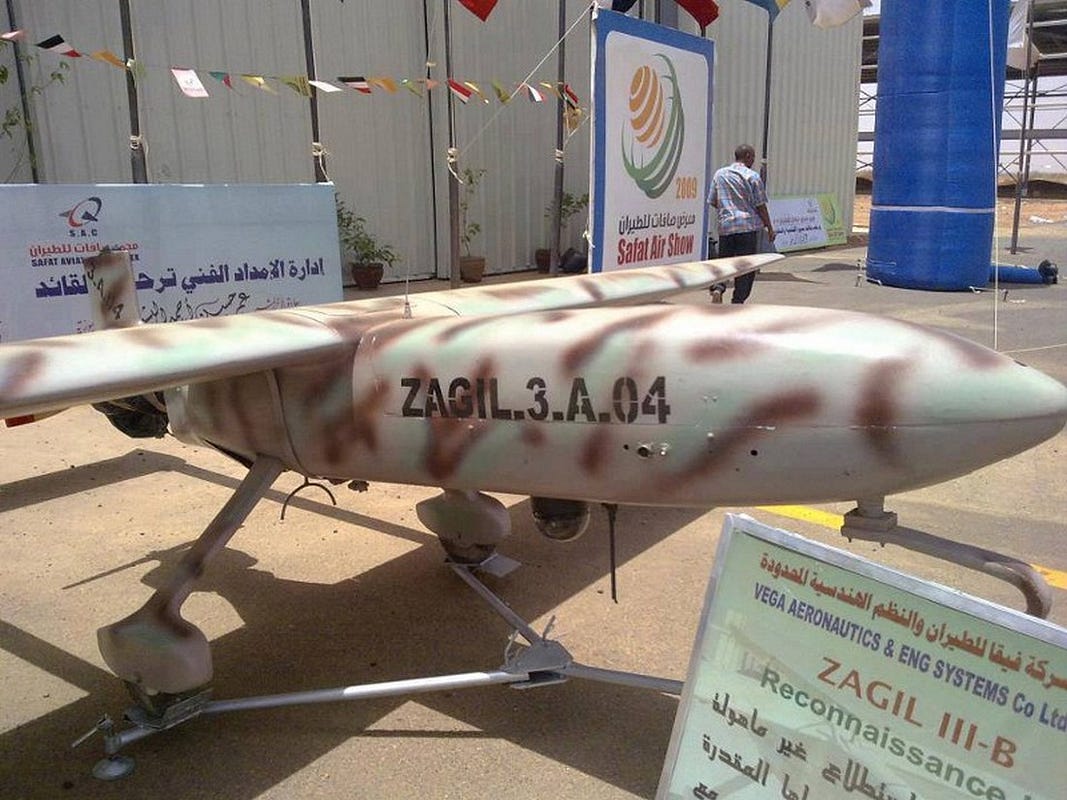by ADAM RAWNSLEY
But who actually owns these robots?
Twitter accounts associated with the militant group Islamic State are tweeting out pics of another wrecked Iranian-made drone in Iraq.
We know Iranian drones have been flying over Iraq for some time now. But the markings on this latest piece of wreckage raise questions about just who owns the flying robots.
The tweets, which first appeared early Saturday morning, claim that Islamic State fighters shot down a drone near the city of Samarra, 70 miles north of Baghdad. The pictures show an Iranian Ababil-3 unmanned aerial vehicle in pieces, with what appear to be stickers of an Iraqi flag on its tail.
The implication is that the drone actually belongs to Iraq, even if Iran manufactured it.
Shortly after Mosul fell to Islamic State forces in June 2014, Iran began flying Ababil-3 UAVs out of Baghdad’s Al Rasheed air base in order to track the jihadists, according to The New York Times.
But the flags on the downed Ababil’s tail could indicate that Baghdad owns and operates the drones. Alternatively, the markings could be a cover—albeit a rather thin one—for Iranian forces deployed in Iraq to help Baghdad battle the militants.
Look, there’s no doubt that the UAV in the recent tweet is Iranian in origin. It bears all the hallmarks of an the Ababil-3, a product of Tehran’s Ghods Aviation Industry.
The twin tail boom and tricycle landing gear are distinctive, as is the serial number 3–2-R 148, which matches the format we’ve seen on other Ababil-3s.
As Iranian military analyst Galen Wright notes, the Ababil from Saturday morning may not be the first Iranian-made UAV to appear in Iraq with the latter’s flag attached. Islamic State published pictures of a Mohajer-4 which it claimed to have captured in July 2014, and featuring what appeared to be Iraqi flag stickers.
It’s certainly plausible that Iran could have sold or donated Ababils to Iraqi forces, since the AB-3 has a documented export history. The Website of Iran’s Ministry of Defense Export Center currently lists the Ababil-3 as available for sale. Iran has displayed the drone at its annual air show on Kish Island.
The Ababil-3 has apparently found a few paying customers. The Ababils are among the most frequently-spotted UAVs flying, and sometimes crashing, in Syria. Sudan, which enjoys a close arms-trade relationship with Iran, has purchased a few of the aircraft, which have turned up in its war with rebels in South Sudan.
Iran has also sold its Mohajer-2 UAV design to Venezuela, which produces them under the designation Arpia-2.
And that’s to say nothing of the UAVs that Iran has provided to its non-state clients. Harakat Al Nujaba, an Iraq-based Shiite militia that acts as a proxy for Iran, showed off pictures of the Yasir, Iran’s knockoff of the Boeing-Insitu ScanEagle drone, back in December 2014.
Hezbollah, Iran’s largest and most capable proxy group, has flown Ababil and Mohajer drones over Israel.
Even with Iran’s extensive drone-export record, the appearance of sticker isn’t sufficient evidence to draw hard conclusions about Iraq’s membership in the international club of drone-owners and -operators. It would be trivially easy for militant fighters to slap stickers on the drone wreckagepost-facto or, as Wright cautions, simply photoshop them into the images.
 In that light, it’s worth noting that the Iranian drones that have crashed in Syria don’t appear to have flag markings on them—Syrian, Iranian or otherwise. Moreover, Iran could very well have deceptively flagged the downed Ababil as Iraqi in order to provide a fig leaf for its involvement in the country.
In that light, it’s worth noting that the Iranian drones that have crashed in Syria don’t appear to have flag markings on them—Syrian, Iranian or otherwise. Moreover, Iran could very well have deceptively flagged the downed Ababil as Iraqi in order to provide a fig leaf for its involvement in the country.
Iran does not frequently admit to its involvement in the conflicts in Iraq and Syria. When it does, public statements often paint slain Islamic Revolutionary Guard Corps troops as defending holy sites, rather than their acknowledging their larger role in prosecuting the wars led by its allies in Damascus and Baghdad.
For instance, Iranian media recently reported that an IRGC soldier Reza Hosseini Moghaddam died while fighting Islamic State in Samarra last week, where the UAV went down and where fighting with the militants has raged lately. Iran’s Tasnim News reported that Moghaddam died protecting the Al Askari shrine, a sacred site for Shiite Muslims.
Regardless of who specifically owns and operates the Ababil-3s in Iraq, Saturday’s crash is further evidence of the proliferation of non-American drones in today’s wars.
Under assault by Islamic State, Baghdad has begged the United States to send American drones to provide intelligence and conduct strikes against the militants. While the U.S. military has been happy to operate American UAVs in Iraq, outright sales of American unmanned aircraft, armed or otherwise, just aren’t on the table owing to U.S. export restrictions.
Whether it’s China allegedly selling armed drones to Nigeria after America nixed Cobra helicopter sales or Iran providing—directly or indirectly—Ababils and Mohajers for Iraq to spy on Islamic State, countries looking for robotic hardware increasingly have options other than the United States.

No comments:
Post a Comment